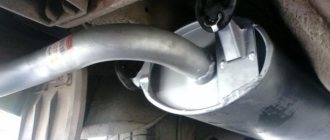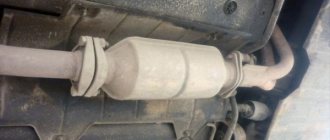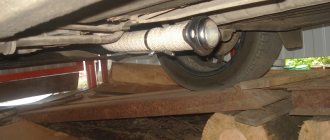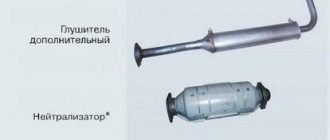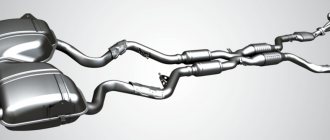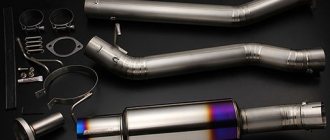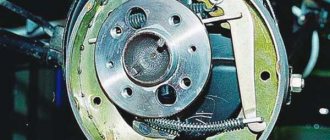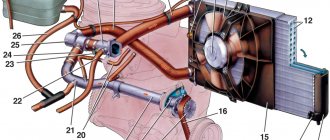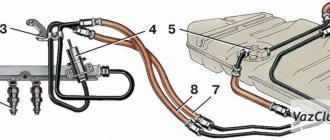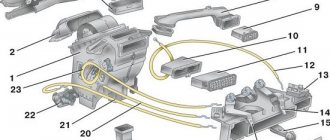Exhaust system diagram
The exhaust system on a VAZ 2106 car consists of an exhaust pipe, a main muffler and a resonator. These elements are needed to clean exhaust gases and reduce the noise emitted by the car’s engine. This is necessary to ensure the comfort of drivers and passengers, as well as to meet environmental requirements.
The VAZ 2106 muffler has a not very good feature - it often burns out and therefore cannot perform its functions. High-quality samples can last from 50 to 70 thousand km, cheap ones work an order of magnitude less. Replacing a muffler takes little time and you can do it yourself.
Return to contents
Replacing the muffler on the “six”
It is advisable to place the car on a pit or overpass, but you can simply raise the left rear side on a jack. The main thing is to provide yourself with space for convenient repairs. Before starting, treat the nuts on the clamp with penetrating lubricant or brake fluid and let it sit for a while. These nuts are exposed to high temperatures while the engine is running, so they are likely to stick to the clamp.
Installing a new part
For work, prepare a hammer, a small chisel, 13mm wrenches and a flat-head screwdriver. Try to remove the nuts with a wrench, but there is no point in unscrewing both. It is enough to completely unscrew one, and just tear off the second. Now you need to arm yourself with a hammer and carefully tap the junction of the main muffler and the resonator. This will allow you to quickly separate the two pipes in the future. Try using your hands or a flathead screwdriver to pry the pipe halves apart.
The VAZ muffler is secured using three rubber clamps: two are located approximately in the middle of the barrel, on both sides, and the third is located at the rear of the car, directly above the exhaust pipe. To remove the latter, you need to remove the cotter pin, and the other two are made in the form of hooks, so there will be no problems with them. The steps for installing a new muffler are performed in reverse order, and it is advisable to replace the rubber clamps securing them to the body.
There is no point in repairing the muffler, since it is very difficult to restore its structure. It is recommended to drill 1-2 holes in the very bottom of the barrel, through which condensate can easily escape.
Return to contents
Replacement of resonator VAZ-2107i injector
Hello everyone, back in the winter on New Year’s Eve the resonator burned out, it was 4 years old, it was inherited from the previous owner, I changed the main muffler about a year and a half ago. I decided to wrap it with asbestos cord until spring, but after a month it burned out, so I wound it again.
Recently it became warmer, and the whipping started again - I decided to replace it.
I bought a resonator made in Tolyatti in advance; the main muffler was from the Seversky Pipe Plant, near St. Petersburg.
It turns out that there are 2 types of injector: Euro-2 and Euro-3. It differs in the bend of the flange and, it seems, in length. Before purchasing, I had to look under the car to make sure I have Euro-2, so the pipe with the flange has a bend, while for Euro-3 it is straight.
For some reason I bought a metal-graphite ring with bolts, which is used to connect the exhaust pipe and the catalyst, in my case they are not needed - the resonator with the catalytic converter has a rigid flange connection. But I think sooner or later they will also come in handy.
I prepared the tools, lubricant and sealant, there was an extra clamp left over from the last time.
With sin, I unscrewed two stuck bolts from the flanges; the clamp on the muffler came off easily, since it lubricated the threads even when replacing the muffler. During removal, the resonator flange completely came off - it was already held on by snot.
I had to unhook the muffler to disconnect the pipelines; the fastening belt broke, but fortunately I have a spare repair kit, also from last time.
The catalyst honeycomb is visible.
Just for fun, I decided to measure the thickness of the metal pipe of the new resonator - it is about 1.5 mm.
It looks well made, the seams are from an automatic machine, for some reason the article number comes from the “six”, although it seems that no injectors were installed on them.
Before reassembling, I lubricated the joints with a thin layer of graphite paste.
During installation, a problem immediately arose - the bend of the muffler began to rest against the bottom of the car - this is the geometry.
I tried this way and that, but still something stuck somewhere - either in the handbrake cable bracket, then in the cable itself, or in the shock absorber.
There was no autogen, to heat it up and bend it, I had to cut off a couple of centimeters from the tip of the resonator pipe with a grinder.
Somehow we managed to move it a couple of centimeters away from the bottom. Before the final tightening, I also lubricated all the bolts with copper grease, and on top of that with graphite grease, and installed new engravers.
I also lubricated the wire securing the muffler belt with pushsal, since everything there also rusts and you have to tear the belt with a mounting tool or saw it.
Upon inspection, it turned out that siphonage was coming from the new resonator at the place where the 2 halves were welded from a small hole of half a millimeter. It was discovered by the condensate coming out - such is the quality of production, they don’t even check the tightness of the seams.
I didn’t have time to drip it with electric welding or cover it with epoxy, I’ll fix it next time.
Subscribe! Good luck on the roads!
Changing the exhaust pipe
The exhaust pipe (in common parlance it is called “pants”) on a VAZ 2106 car is attached to the exhaust manifold. Before starting the repair, it is necessary to disconnect the battery, since it is located quite close to the pipe, so the probability of shorting the wire going to the starter is very high. Complete removal of the battery from the car is not required - just disconnect the negative terminal. To work, you need an inspection hole, overpass or lift, since you will have to carry out some manipulations in the lower part of the car.
Replacing the exhaust pipe
The four nuts that secure the pipe to the exhaust manifold are secured with a flexible plate. It needs to be bent to release the edges of the nuts. Using a 13mm wrench (it is best to use a socket or socket), completely unscrew the nuts and inspect them for damage. If the threads are broken or the edges are worn out, it is better to replace the parts with new ones. Please note: simple steel nuts cannot be installed! They should be made of brass or bronze so that they do not stick to the studs. Now pull the pipe, then remove the gasket and clean the surface of dirt.
All elements of the exhaust system are exposed to high temperatures, so reusing the gasket is prohibited, as it will not be able to provide the required level of sealing. Now you need to get under the car and unscrew the bolt that secures the pipe to the gearbox. You will also see a clamp connecting the resonator to the exhaust pipe. Apply penetrating lubricant to the threaded connection on it to make it easier to unscrew the nuts. Give the grease time to soak in, then remove the nuts and move the clamp to the side, making room for repairs.
Using a hammer, gently tap the pipe at the joint, then try to separate it with your hands. Be careful not to cut yourself or hit your hands or head. After disconnecting, remove the old exhaust pipe and install a new one. Do not rush to completely tighten all threaded connections under the car. First you need to install a new gasket on the exhaust manifold studs. It is recommended to lubricate it on both sides with CV joint grease so that during operation it does not burn to the surface of the pipe or manifold. Then place the pipe and attach all four nuts. Tighten them carefully, crosswise, so as not to deform the gasket.
After final tightening, the nuts must be locked and installation of the clamp at the junction with the resonator can begin. Replacing a VAZ muffler and replacing the exhaust pipe are very similar, only they are carried out in different parts of the car.
To change the resonator, you will need to perform the same manipulations, only the clamps are removed at the same time, and the muffler and exhaust pipe remain in place. And you will have to tap two joints to remove the resonator. With the new exhaust system, the VAZ 2106 will run much quieter, and the engine will emit less harmful substances into the atmosphere.
In this article we will look at the exhaust system of the VAZ 2106 car. In particular, we will pay attention to the design of the exhaust system, the process of replacing worn-out elements, as well as the most common tuning options.
Muffler mount
Each element of the exhaust system is fixed to the bottom of the car in a different way. For example, the exhaust manifold is “tightly” screwed to the engine with powerful bolts to eliminate the possibility of gas leakage. But the “glushak” itself is attached to the bottom with special rubber hangers on hooks.
This method of fixation allows the muffler to resonate during operation without transmitting additional vibrations to the body and interior. The use of rubber hangers also makes it possible to conveniently remove the muffler if necessary.
The muffler is attached to the bottom of the car using suspensions, which create a reliable fixation and avoid unnecessary vibrations on the body
Exhaust system design of VAZ 2106
The exhaust system is completely similar to the exhaust systems of the entire VAZ “classic” model range (VAZ 2101-07). By the way, a little earlier we already examined the exhaust system of the classic Zhiguli model: Exhaust system of the VAZ 2107.
Structurally, the exhaust system of the VAZ 2106 consists of the following elements:
1. The intake pipe, which connects to the exhaust manifold pipe. At the same time, the connection point is protected by a heat-resistant asbestos gasket.
2. Additional first stage muffler.
3. Additional second stage muffler. The first and second mufflers are connected to each other via a so-called telescopic connection.
4. The main muffler, which is fixed with a rubber cushion.
5. Telescopic connection.
Popular method of installing direct flow
One of the options for transforming a regular muffler into a sports muffler involves the presence of the following materials and tools:
- Iron pipe with a hole size of 52 mm (ideal for domestic VAZ models running on a 1.6 l engine).
- Welding machine.
- Grinder with an attachment for cutting metal.
- Metal pipe cleaners in the amount of 50-60 pieces.
Let's move on to the actual tuning process:
The old muffler must be removed. Use a grinder to cut a groove along the entire length in the resonator.
Attention. Thus, a recess should be obtained that gives access to all internal parts of the resonator
All internal components of the resonator are cut out with the same grinder. These will be stiffening ribs, many pipes welded together, etc.
Important. The tubes should not be cut out at the root, but should be left 3-4 cm on each side
This needs to be done so that the new pipe has something to weld with.
- The prepared pipe is cut according to the obtained dimensions (its length should be equal to the segment between the cut ends of the resonator pipes).
- You need to make a lot of holes on the pipe every 1.5-2 cm.
Advice. You can make a hole in the pipe with a drill, but it will take a long time. It will be easier to use a grinder, making cuts at certain distances. As a result, the pipe should have a pattern resembling a herringbone.
- The resulting pipe section is welded to the ends of the resonator tubes.
- The free space of the resonator is clogged with pipe cleaners.
- The cut outer part of the resonator, the “lid” so to speak, is welded back.
- The end of the muffler is cut off.
DIY exhaust system repair
Replacing the main muffler of a VAZ 2106 with your own hands
Before starting repairs, let the entire system cool down. Working with hot pipes is simply unsafe. From the tools we need two 13mm wrenches, as well as a straight screwdriver.
1. Using a wrench, loosen the clamp nut a little, and use a second wrench to hold the bolt from turning. Next, use a screwdriver to unclench the clamp, and then move it down the inlet pipe of the main muffler.
2. Now use a wrench to unscrew the bolt that secures the rubber cushion. After this, disconnect the pillow from the mounting bracket, push it out and remove it.
4. Remove the rubber muffler hangers by pressing the wire fasteners.
5. With some effort, rock the muffler and disconnect it from the additional muffler. After disconnecting, remove the main muffler.
We install the new muffler in the reverse order of removal.
Exhaust System Mounting Parts
A clear understanding of the algorithm of actions when carrying out such an event as replacing a VAZ 2107 muffler will help every car enthusiast carry out his plans quickly and without errors. On the one hand, removing the old muffler and installing a new one seems simple, but on the other hand, you need to be prepared for some difficulties.
Why and how often is it necessary to change the VAZ 2107 muffler?
The exhaust system of a car, despite its relatively simple design, performs many functions. The main ones are:
- removal of fuel combustion products;
- significant reduction in exhaust sound level;
- maintaining air balance with the intake system;
- ensuring effective cleaning and ventilation of cylinders.
The VAZ 2107 muffler experiences enormous loads like no other part of the car. First of all, constant temperature changes have a destructive effect on the metal, which actively destroys not only the protective paint and varnish coatings, but also the structure of the metal itself.
Gases heated to a high temperature literally “eat up” the internal filling of the muffler, mixing with water condensate and oils, dissolving the metal walls, forming through corrosion. Externally, the muffler elements are also adversely affected by moisture, road sand and gravel; salt solutions in winter intensify the decomposition process.
As a result, after some time the driver can observe under the bottom of the car the pitiful remains of what was once called a muffler. Whether we like it or not, the muffler of a VAZ 21074 or any other model will have to be changed periodically. To the question of how often you should change the muffler, every car enthusiast must find the answer himself.
The service life of an exhaust system, like many others, depends on factors such as:
- activity of vehicle operation;
- quality of fuel used;
- the car owner’s attitude towards the condition of the car;
- frequency of use of the machine in adverse weather conditions;
- quality of previously installed exhaust system parts.
Having come to terms with the fact that the VAZ 2107 muffler will not last forever, you need to buy a new one and start replacing it.
Replacing the VAZ 2107 muffler - procedure
An inherently simple procedure can take a lot of effort and time. Before installing a new muffler, you must remove the old one. To do this you should:
- install the car on an overpass or above an inspection hole;
- prepare a set of tools, ensure good lighting under the machine;
- The muffler is connected by a pipe to the resonator pipe in front of the rear axle. The ends of pipes with a slot and a male-female connection are tightened from the outside with a coupling;
- Corrosion under the influence of lubricant and temperature can solder the joints so much that it becomes very difficult to remove them. It is better to moisten the pipes at the junction and the coupling in advance with a solution that corrodes corrosion. For this purpose, as a last resort, brake fluid or used oil is suitable.
The procedure for replacing the muffler is as follows:
- the crimp coupling is untwisted or cut off using a cutting tool (grinder) (in this case, a new coupling should be on hand);
- use a thin chisel or screwdriver to bend the flared edges of the pipe;
- the muffler is disconnected from the resonator (if it comes out tight, you can help yourself with a hammer by tapping on the pipe);
- hanging pillows are detachable. By the way, when buying a muffler, it is advisable to buy three suspension rubber bands (two in the center and one at the rear).
After this, the old muffler is in your hands and you can install the new one in the reverse order.
How to replace the muffler of a VAZ 21074 and other modifications of classics
Very often, car enthusiasts, seeing in the title of the article that the make of the car does not exactly match what is indicated in the registration certificate, continue to search for instructions. VAZ cars are charming because they differ from each other for the most part only in appearance, but the internal structure is completely identical.
It doesn’t matter what kind of car is in the garage: 2105, 2104, 2107 or 21074 - their exhaust system is completely the same. Having studied the repair instructions for one car, you can safely begin repairing another classic model.
Removing and installing additional mufflers
The first and second additional silencers are not attached to the car body. Additional mufflers are connected to the inlet pipe of the main muffler using a clamp clamp. The replacement process will look like this:
1. First, remove the main muffler, as was described a little higher.
2. Loosen the clamp nut a little, use a screwdriver to separate the clamp and move it along the pipe. Rock the mufflers and disconnect them from the exhaust manifold pipe.
If at the junction the pipes are strongly stuck to each other and it is problematic to disconnect them manually, you can go a slightly different route. To do this we need a gas key. With its help, we turn the pipe with mufflers and remove it.
Additional reasons
There are a number of other reasons why the exhaust pipe shoots. These include:
- Popping noises when idling the engine are possible for two reasons - a leak in the intake manifold, as well as a clogged idle system.
- Poor quality gasoline or gasoline with a low octane number. Try to refuel at reputable gas stations and use fuel recommended by the manufacturer of your car.
- Mixed spark plug wires. If, when replacing or checking spark plugs, you mixed up the wires connected to them, this will also be a likely cause of popping noises. In this case, the car may not start and “shoot” at the muffler.
- If your machine has an economizer, check its operation. Often the malfunction of this unit is also the cause of “shots”.
- Malfunction of the air damper. Check this element and adjust if necessary.
- One of the reasons when the muffler shoots when releasing gas is that the muffler downpipe (“pants”) is poorly screwed to the exhaust manifold. Check the tightness of the connection and tighten it if necessary.
- Another likely cause of popping noises is high performance fuel injectors (“leaking”). They supply too much fuel, which does not have time to burn completely, which leads to “shots”. There is a simple way to check. It is necessary to try to start the engine at high engine speeds (with the gas pedal depressed) (the so-called purge mode). If popping noises occur at this time, it means that at least one injector is leaking.
- In injection cars, late ignition and, as a result, popping noises can be caused by “fatigue” of the knock sensor. It can also respond to extraneous noises occurring in the engine. The operation of the sensor must be checked using computer diagnostics.
- If the muffler shoots when releasing gas, then one of the most common reasons for this is “burning” of the exhaust valves. Popping noises may also appear when descending a mountain in gear. Inspect and clean them.
- If your car uses a contact ignition system, then you need to check the gap on its contacts. Ignition problems, as described above, may be the reason that not all of the gasoline is burned.
- Leakage of the gas exhaust system. In this case, as a rule, single pops occur when the gas is released. First of all, check the gaskets at the connections of the pipes (catalyst, resonator, muffler).
Also, if lumbago occurs and traction deteriorates, it is recommended to check the fuel pressure in the system, as well as compression (cylinder tightness for leaks), and inspect the ignition coil.
Condensation in the muffler
The main reason for the formation of condensation in the muffler is the temperature difference between the ambient air and the muffler. Its formation in a car with a working catalyst is a natural phenomenon. It’s worse if it’s not there, but too much can cause corrosion. There is a Read more
As you can see, there are many reasons why a muffler shoots. Therefore, we advise you to start your diagnostics by checking the tightness of the exhaust system. Inspect the bolted connections and gaskets between its individual elements. This will save you time and money. This is especially true if popping noises are heard when releasing the gas or when descending a mountain in gear (when braking the engine).
If the audit does not give positive results, then it is necessary to check the operation of the carburetor, valves and other parts described above. This check is advisable if the muffler shoots when you press the gas.
Exhaust system tuning
Installation of a metal expansion joint
This is perhaps one of the easiest ways to modify an existing exhaust system. Why do you need a metal compensator? Let's figure it out. The thing is that as a result of the constantly changing torque, the power unit is in constant oscillation. At the same time, these vibrations are also supplemented by inertial forces that arise during acceleration/braking and when moving over various types of irregularities.
Among other things, a working power plant is a source of not only the vibrations mentioned above, but also vibrations of a higher frequency, generated, for example, by a crank mechanism. Of course, all these vibrations are transmitted not only to the body, but also to all elements of the exhaust system.
In order to eliminate the impact on the car body of a constantly “walking” engine, a metal compensator is installed. It will significantly reduce vibrations of pipes and mufflers, which will increase their durability and reduce noise inside the car.
Let's move on to the installation process. It should immediately be noted that the metal compensator is installed in the section between the exhaust pipe of the manifold and the inlet pipe of the first additional muffler. The part is installed as close to the exhaust manifold as possible. When choosing a compensator, be sure to glue it so that its diameter matches the diameter of the exhaust system pipes of the VAZ 2106.
To complete the work we will need: an electric drill, an angle grinder (“Binder”), a tap for threading (M5), M5 screws, heat-resistant sealant.
The installation itself looks like this:
1. Remove the main muffler, and then additional ones using the technology described above.
2. Now, using a grinder, we cut off a small section from the inlet pipe of the first additional muffler. The length of this segment should be slightly less than the length of the metal expansion joint being installed.
3. We put the metal compensator on the pipe of the additional muffler and drill holes with a drill. The drill diameter should be 4.2 mm. We do the same with the second part of the pipe.
4. Using a tap, cut threads in the drilled holes.
5. Lubricate the pipes with heat-resistant sealant and install a metal expansion joint. Then we apply a little sealant to the threads of the screws and screw them into the pre-prepared threaded holes.
There is a more technologically advanced option for installing a compensator - using welding. This method will allow you to get a much more reliable connection, and the installation process itself will be much faster.
Installation of a direct-flow exhaust system on a VAZ 2106
A direct-flow exhaust system is a much more serious way of tuning a standard system, compared to installing a metal compensator. Why is a forward flow installed? Firstly, to increase the power of the power plant, and secondly, to obtain a more “aggressive” sporty exhaust sound.
Today, the modern market of auto parts and components offers a fairly large assortment of direct flow systems, including for cars of the VAZ family. When choosing such elements, it is very important to remember one thing. The overall dimensions of the forward flow are proportional to the volume of exhaust gases produced by the engine over a certain time. In this regard, if the engine has been boosted, for example, the standard camshaft has been replaced, the volume of exhaust gases increases significantly. This should be taken into account when selecting the appropriate forward flow.
As for the design, the direct-flow muffler resembles a resonator, the internal space of which is filled with a special material with high sound absorption. An example of such a sound-absorbing material is basalt wool. By the way, the durability of a tuned muffler directly depends on the length of time the sound insulation is in it.
About the installation. Unfortunately, installing a direct-flow exhaust system with your own hands is quite problematic, because this will require the ability to work with welding. That is why the best solution would be to seek help from experienced mechanics. In any case, it is important to understand that parts for direct flow, just like the services for its installation, are quite expensive.
In a VAZ 2106 car, the exhaust system plays a rather important role. Indeed, if it fails, problems may arise directly with the engine. Therefore, at the slightest breakdown of the device, it should be repaired immediately or completely replaced, otherwise the excessive accumulation of gases will slowly destroy the machine from the inside.
VAZ 2106
Content
Pros and cons of installing direct flow on a car
Installing a direct-flow system has both pros and cons. Each motorist decides for himself how appropriate it is to modify the car muffler in favor of direct flow.
Pros of direct flow:
- If a pipe with a slightly larger diameter than originally installed is welded on, it is possible to increase the exhaust gas throughput. An increase in airflow leads to an increase in engine power, up to 15%;
- Increasing the service life of the muffler. Most often, the muffler “from the factory” is not made from the best materials, but with such a modification, the motorist can use good pipes, even titanium options. If you want to increase the “lifetime of the pipes,” then after welding the resonator, you need to remove the end of the muffler with a grinder and solder a new pipe in its place, having thoroughly cleaned and primed it in advance.
Disadvantages of forward flow:
- Increased noise. Many car enthusiasts consider this parameter a plus and install the direct flow with their own hands solely for the purpose of increasing the “rumble” of the car when driving;
- Reducing the vehicle's ground clearance if pipes of larger diameter are welded onto the muffler;
- Problems during maintenance. Increased noise and the absence of a catalyst will lead to problems during maintenance;
The method of installing a direct flow with your own hands, described in this article, can be called “collective farm”. In professional racing cars, the direct-flow system is much more complex and is designed primarily to improve engine performance. At the same time, such a forward flow is unlikely to bring much benefit, only changing the sound of the car, which, in most cases, is the goal of independent tuning.
Materials and tools for manufacturing: - pipe, diameter is selected depending on the brand of car (VAZ usually has a diameter of 52 cm); — welding; — grinder and discs for cutting metal; — iron sponges for washing dishes (50-100 pcs.).
The manufacturing process of a direct-flow muffler based on a standard one:
Step one. Removing the muffler
First of all, you need to remove the muffler from the car. A VAZ car is considered as an example. Next, take a grinder and cut out a piece in it, as can be seen in the photo. Subsequently, all the insides of the standard muffler are dismantled.
According to the author, at engine speeds of 2500-3000 rpm, the engine sound is not audible in the cabin. At higher speeds the sound is already audible, but it is not as bassy as that of the “can”. From the outside, this muffler looks like a standard one, but is slightly longer.
Another way to make a direct-flow muffler
There is another option to make a direct-flow muffler, here only individual elements are used. Most often, two schemes for manufacturing such mufflers are used. Diagram No. 1 shows a reverse flow exhaust, and diagram No. 2 shows how a sports direct-flow muffler works. This muffler will be made exactly of this type.
The photo shows another similar direct flow with your own hands
The muffler is an element of the engine exhaust system. Its presence does not depend on the type of fuel the engine runs on - gasoline, diesel fuel or methane. The muffler dampens sound vibrations, helps attenuate, subside and resonantly reduce sound waves from engine exhaust. Interlocutors will not be able to communicate around a running engine without a muffler. The noise of the engine will drown out their speech. Nevertheless, many car owners dream of remaking the exhaust system and making it forward-flowing. Some people can create it with their own hands.
Device functions
You need to understand that the exhaust system plays an irreplaceable role, so it should be given due attention.
Let's consider the main purpose of the muffler through its advantages:
- It serves to reduce the content of pollutants in exhaust gases;
- The exhaust gases make less noticeable noise;
- When performing all the above functions, the VAZ 2106 engine does not lose power.
Processes
Considering how the muffler works and is designed, we can distinguish three main processes:
- Distribution of gases throughout all tubes in the engine;
- Damping sound waves so that the noise becomes less pronounced;
- The predominance of shock waves in a medium that consists mainly of gaseous matter;
MANUFACTURERS OF RESONATORS FOR VAZ 2107
In the post-Soviet space you can purchase resonators from many manufacturers. The production devices in greatest demand are:
- OJSC AvtoVAZagregat (manufacturer of original parts);
- OJSC Togliatti Plant of Technological Equipment;
- LLC "Izhora Silencer";
- TRANSMASTER UNIVERSAL (manufacturer of exhaust systems made of regular and stainless steel).
There are no big differences between the products of these brands. The service life of resonators made of refractory steel is approximately the same and amounts to 20-30 thousand kilometers. The service life of stainless steel products is approximately twice as long, but the price is one and a half times higher than the price of analogues made of ferrous metal.
Stainless steel resonators last much longer than conventional ones, but they also cost significantly more.
Effect on the engine
Muffler VAZ 2106
As you know, engine power is directly proportional to the torque and speed of rotation of the crankshaft and is calculated by multiplying them. In this case, how quickly the crankshaft rotates depends on the filling of the cylinder with the fuel-air mixture. As a result, it becomes possible to influence the rotation of the shaft with the help of successful gas distribution. And if the muffler is plugged with something (for example, potatoes), then the pressure here will not decrease, which will make clearing it of gases almost impossible. This, in turn, will increase the pressure in the manifold, so the cylinder cannot be cleaned when the exhaust valve opens.
Because of this, a large amount of exhaust gases will remain here, which will prevent the cylinder from filling with a new mixture. This will cause the device to not be able to rotate at the same speed. Therefore, glitches will appear during its operation.
In the VAZ 2106 car, the special design of the muffler ensures that the amount of exhaust gases is well compatible with the content of the fresh mixture entering here. Therefore, the functions of the exhaust system are performed as efficiently as possible.
However, such a device does not increase power, so the amount of horsepower in the VAZ 2106 is quite low. In this case, you can perform engine tuning, which will help increase its power. Thus, the exhaust system affects the operation of the engine, but even if it is in perfect condition, the engine power does not increase.
Compressor or turbine for the “six”
You can increase engine power by installing a compressor or turbine, but first you need to figure out what is required for this. First of all, you need to understand that, due to its design features, it is possible to install a turbine on a carburetor engine, but it is quite problematic. The nuances include both large material and time costs. The most important points to think about when equipping a car with a turbine are:
- Mandatory installation of an intercooler. This part is a kind of radiator, only the air is cooled in it. Since the turbine creates high pressure and the air is heated, it must be cooled to obtain the effect of the installation. If you don't use an intercooler, there will be an effect, but much less.
- Equipping a carburetor engine with a turbine is a dangerous undertaking. According to the experience of car owners who carry out such modifications, the exhaust manifold may “bang” and the hood will fly off. Since the intake principle on an injection engine is different, a turbine for this engine is a more preferable option, albeit an expensive one.
- Based on the second point, the third follows - it will be necessary to convert the engine into an injection one or install one.
Installing a turbocharger on a car requires a large financial investment.
If you are not such an avid racing driver, then you should look towards a compressor, which has the following differences from a turbine:
- Does not develop high blood pressure.
- There is no need to install an intercooler.
- You can equip a VAZ carburetor engine.
To equip a VAZ 2106 with the unit in question, you will need a compressor kit - a kit that includes everything necessary for converting the engine (pipes, fasteners, supercharger, etc.).
The compressor kit for the “classic” consists of a supercharger and the necessary components for installation
The product is installed according to the manufacturer's instructions.
How to configure the muffler?
The VAZ 2106 is a car in which almost all stages of repair, replacement or improvement can be done directly with your own hands, since they are very simple.
In order for the system to be configured correctly, the following points must be taken into account:
- It should not contain any reflective elements. Otherwise, resonant frequencies may appear that dissipate the energy of the shock waves. That is, in the exhaust pipes, in no case should there be sudden changes in the cross-sectional area, since the exhaust gases will be distributed unevenly throughout them;
- It is important that the pipes at the joints are thermally insulated. To do this, they can be wrapped with special insulating materials;
- The connections must be flexible, otherwise the pipes will often break;
- During work, use special devices that can measure engine torque and speed.
–> VAZ Masters / Air filter and exhaust system / Muffler
Replacing the muffler VAZ 2106
Ways to muffle the exhaust sound
Before tuning the exhaust system, you need to understand the reasons why the sound of the engine becomes louder over time. The operation of the engine itself is a fairly loud process, but the muffler and other components of the exhaust system perfectly suppress this loud noise. Without a muffler, the engine noise is very loud.
The noise occurs because the fuel mixture explodes in the combustion chamber, releasing gases that then exit into the exhaust pipe. We will not talk in detail about the operation of the engine, you can read about this in another article, but here we will talk specifically about how to muffle the exhaust sound.
The explosion releases energy that pushes the piston, and when the piston has moved the required distance, the exhaust valve opens, through which the exhaust gases exit and go further through the exhaust system. To effectively absorb noise, thick metal parts are used. So, the thicker the metal used in the exhaust system, the quieter the car will drive due to the fact that there will be less vibration.
The exhaust manifold is the first one to absorb the noise, which is why it is made so large and thick, so it best dampens the noise that comes from the cylinder block. Even if you compare the exhaust pipe of any more or less normal foreign car with the exhaust pipe of a domestic car, you can see that in foreign cars the pipe is heavier and thicker, which is why such a car runs quieter.
This is why when you drive an old VAZ 2114, the noise is such that you can’t hear what the passengers in the rear seats are saying, which is why you start thinking about how to muffle the exhaust sound.
The exhaust system also has a resonator, which is needed to reduce the speed of gases through the exhaust pipe. And after the resonator comes a muffler. When exhaust gases pass through the resonator, they lose some energy and continue to flow more slowly.
Gases lose the largest share of their energy in the muffler. If we consider a good muffler, then it contains several separate housings, after passing through which little remains of the noise.
How to choose the right muffler
The muffler is not only an important car part that performs purely operational functions. Not at all. According to statistics, passers-by pay attention, first of all, to the car’s rims and its muffler. In other words, this part also performs aesthetic functions, being a stylish decoration for the car.
Beautiful muffler on a car
It’s not for nothing that a stylish muffler is compared with alternative optics, beautiful body kits and alloy wheels. After all, it creates the appearance of the car, ideally combined with the above details. As mentioned above, the muffler also performs the main operating function. It copes well with excess noise and sound, although it slightly muffles the engine power. But to think that a car will go faster without a muffler is wrong. There is no trace of this, because the engine power decreases slightly, especially if you know what type of muffler to choose. First you need to understand that there is no such exhaust system that would increase engine power. And installing a muffler from a cool car with a powerful engine on a car does not mean that the engine will improve its capabilities. On the contrary, if you install a muffler whose parameters do not match the system, you can not only weaken, but also destroy the car’s engine. After all, the car production company’s specialists, even domestic ones, do not allow any gross miscalculations. But on the other hand, the manufacturer is sometimes limited in the choice and means to improve the design and some of the nuances of this part.
Exhaust systems are selected individually, depending on the type of engine . A special program is selected for the engine, designed for a complete tuning complex. Each individually selected exhaust system must ensure maximum engine performance. For example, an exhaust system fitted to the factory standard version will not work with sufficient efficiency on a forced engine. And the same can be said in the opposite case, when a forced exhaust system is installed on a standard engine. Therefore, for example, the Austrian company Remus never offers its customers already configured exhaust systems. After all, installing a forced system on standard engines means wasting extra money, which in the end will lead to nothing. If replacing the exhaust system of a domestic car with a forced one does not give anything, then why is this done by car enthusiasts? Is it just a matter of appearance? It turns out not at all. The reason lies in the sound. What driver, especially of a stylish six, wouldn't want to hear the racing car sound coming from the engine? And a real, clean and beautiful sports sound can only be produced by a muffler that is matched to a forced exhaust system. It turns out that the main criterion when choosing a muffler is sound. It is this characteristic that many manufacturers do not pay due attention to.
Material
Muffler with galvanic coating
Replacing the muffler VAZ 2106
Repairing the exhaust system of a VAZ 2106 car involves several actions:
- Replacing the exhaust pipe
- Replacing the main muffler
- Replacing the additional muffler
A specific type of work is carried out depending on the situation. Let's take an example of how to replace a muffler on a main VAZ 2106:
- we lift the car onto the inspection hole;
- We take two keys - with one we hold the clamp bolt from turning, and with the other we unscrew the nut;
- Unclench the clamp with a screwdriver and lower it down onto the outlet pipe of the additional muffler;
Removing clamps on a VAZ 2106
- we find the lower bolt fixing the pillow and turn it out;
- disconnect the cushion from the bracket, pulling the muffler down in advance;
- disconnect the muffler belts one by one, pressing the body from bottom to top.
Advice. To more conveniently disconnect the muffler belts, you can use a screwdriver.
- turn and simultaneously rock the muffler, thus removing it from the outlet pipe;
- remove the clamp of the exhaust pipe of the additional muffler;
- carefully inspect the muffler suspension cushion and belts (if necessary, replace them with new ones);
- install the new muffler in reverse order.
Advice. In order for the pipe joints to be sealed correctly, it is necessary to apply a layer of special sealant intended for exhaust systems to the outer surface of the outlet manifold before installation.
Replacing additional mufflers
Replacing an additional muffler for a VAZ
These parts are not attached to the body of the VAZ 2106. They are fixed to the exhaust pipe and the main muffler using clamps. So, we arm ourselves with two 13mm wrenches and a screwdriver. Helpful, also watch this video
Begin:
- remove the main muffler as described above;
- unscrew the nuts securing the clamp;
- Unclench the clamp with a screwdriver, moving it slightly forward onto the exhaust pipe;
- by rocking and turning, disconnect the muffler from the exhaust pipe;
- remove the muffler from the car, directing the movement down and forward.
Turn part of the pipe with a gas wrench
Resonator - what is it?
The resonator is the name given to the main muffler (usually it looks like the widest pipe in the VAZ exhaust system). The main task of this element is to promptly remove exhaust gases from the system to make room for new ones.
It is believed that the entire useful power of the motor depends on the quality of the resonator. Therefore, the resonator on the VAZ 2106 is located immediately behind the forward flow in order to absorb the main flow of hot gases.
Resonator Euro 3
With the development of the automotive industry, mufflers also developed. Thus, a EURO 3 class resonator for a VAZ is no different from EURO 2, however, to optimize engine performance, it has a special hole for installing a lambda probe. That is, the EURO 3 resonator is considered more functional and modern.
On the first VAZ 2106 models there was no resonator
Thus, the muffler on the VAZ 2106 needs special attention from the driver. The design is extremely short-lived, so it is better to periodically drive the car into a pit and inspect all elements of the exhaust system than to end up on the road with a rotten pipe.
Description of the exhaust system design
Exhaust system parts:
1 — bolt M4x45 pillow (15891211); 2 — muffler suspension cushion (2101-1203072); 3 — main muffler (2106-1201005); 4 — muffler suspension belt (2101-1203047); 5 — bolt M8x75 of the clamp (16044721); 6 — coupling clamp (2101-1203032); 7 — bolt M8x80 of the clamp (16044821); 8 — coupling clamp (2101-1203031); 9 — nut for fastening the exhaust pipe (2108-1203019); 10 — locking plate (2121-1203075); 11 — laying of the exhaust pipe (2103-1203020); 12 — exhaust pipe (2101-1203010-10); 13 — additional muffler (2103-1202005); 14 — bolt M8x30 of the clamp for fastening the exhaust pipe (16043821); 15 — clamp for fastening the exhaust pipe (2101-1203043)
The exhaust system consists of a reception pipe, additional and main mufflers. The intake pipe flange is attached to the exhaust manifold with four studs with brass or copper-plated steel nuts. The nuts are secured in pairs with locking plates. The connection between the collector and the intake pipe is sealed with a reinforced metal-asbestos gasket. The exhaust pipe is additionally secured with a clamp to the bracket on the gearbox.
The additional muffler is a structure consisting of front and rear mufflers. On a VAZ-21063 car, the additional muffler consists only of the rear muffler and is marked 2101-1201005-01. The front muffler pipe is placed on the exhaust pipe, and the rear muffler pipe is inserted into the main muffler pipe. The joints are fixed with clamps.
The main muffler is suspended from the underbody brackets on two rubber straps with hooks and a cushion.
Attention! Work related to the repair or replacement of the exhaust system must be performed only after its parts have cooled.
Source
